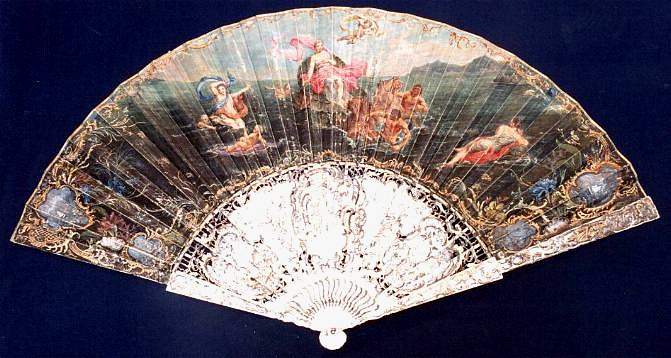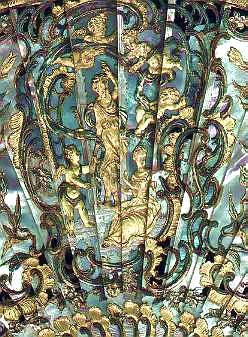|

|
|

|
A Louis XIV first painter fan
We invite you here to examine in detail a fan, in order to go beyond its appearance: technical prowesses, artistic correspondences, history are indeed present in these objects which one regards sometimes only as simple " costume accessories".
Don't hesitate to exercise your criticism, to react and suggest (including by showing your own fans !)

From where did the fan painters take their subjects?
It is known that at the end of XVIIth century and the beginning of XVIIIth century, the fans were often painted reproductions of the noble painting of the time, with biblical or mythological subjects.
These reproductions were generally carried out according to engravings rather that to original paintings. This explains that they oftent seem reversed compared to the original. The amateur of fans or the researcher does not remain about it less in difficulty when it is a question of finding the work of art taken as a basis by the fan painter (or often, in France, " peintress ", member of Saint Luc brotherhood).
Admittedly, these paintings were often extremely famous, and it is easy to recognize the subjects. However, certain renowned painters in 1700 are now known only by specialists, many original works have disappeared, and even the prints or other engravings could have became rare. Moreover, the adaptation of work te the semi-circular shape of the fan sheet (or with the customers tastes ?) brought modifications which can make the identification more difficult.
Difficult identification of the fan
The fan is generally not signed in spite of extremely rare exceptions at the period which worries us here. However there is sometimes a tradition which indicates the nature of the subject, and the painter who was used as model. Be aware that this tradition may be false, including in prestigious collections (thus the fan of the Mary Queen of England, reproduced by the revue " The Gentlewomen " under the false name of " Rinaldo in the gardens of Armida ".)
The fan above, as for it, was described in an auction sale like " folding fan with mother-of-pearl pierdced, carved and gilded sticks, leaf with a painted scene representing e the triumph of Galathea, in an entourage of flowers and reserves. The other face presents an allegory in a broad flowered reserve. XVIIIth century ".
These some indications correspond indeed to appearance, but leave us still hungry.
By chance, we discovered while browsing in a secondhand bookseller, in the excellent " Revue du Louvre et des Musées de France" (n° 4-1985) an article of Helene Guicharnaud, entitled " the Four Elements of Louis de Boullogne : preparatory studies "
This article enabled us to attach our fan to a print of Louis Desplaces (1682-1739), engraved in 1718, and forming part of the " Four Elements " according to Louis de Boullogne (cf infra). It is here Water (Amphitrite triumph and of Neptune).
Louis de Boullogne le Jeune
Louis de Boullogne1, known as " the Young " (19/11/1654-21/11/1733), belonged, with his father, Louis " the Elder" (Paris, 1609-1674), and his elder brother " Bon ", but also with their sister Madeleine , to a famous family of painters, which was very successfull. Louis the Father or the Elder took part in the decoration of the Louvre and Versailles. He was one of the fourteen founders of the Painting Academy and gave his children a solid traditional formation.
First "Prix de Rome" in 1673 with the "Passage du Rhin", Louis de Boullogne the Young joined the Academy in1681 on presentation of its "Auguste orders to close the gates of Janus Temple" ( Amiens Museum). Appointed professor into 1694, he became director in 1722, and succeeded to Coypel in 1725 as "King's First Painter". Louis XIV had one year before raised him to nobility. Before dying in 1733, he could discover the talent of Maurice Quentin de LaTour.
The Louvre preserves many studies, in particular dealing with the engraving we evoke here. For further explanations, the reader may lrefer to the article quoted above.
Works of Louis of Boulogne are preserved in many museums, in particular in France, but especially in Versailles.
With his brother Bon, Louis " the Young " made the tour to Italy and took as a starting point the lessons of Raphaël and of the bolonese school. He worked in Versailles and the Invalids, where painted (amidst other works) two of the " Four Elements " : ("Junon orders Eole to unchain the winds against Aeneas fleet" 1699; "Venus urges Vulcan to make weapons for Aeneas", 1704). We suppose, without being able to affirm it, that the painting which interests us was also carried out for the Invalids.
Dijon, musée Magnin IIt will also be noted that the relationship, for the Boullogne brothers, was an artistic as much as a family one. We give here a "thumnail" of a " Triumph of Amphitrite " by Bon de Boullogne .
1 See Schnapper, Antoine & Guicharnaud, Helene. LOUIS OF BOULLOGNE, 1654-1733. (Livres du dessin français No 2.) Paris/Boston (Gallery of Bayser/Ars Libri, Ltd.), 1986
Comparative study
Comparison of the two works, engraving and fan, undoubtedly allows us to affirm that the first was used for the realization of the second. However, one notices significant changes, of a nature frequently met in this matter:
1) disappearance of characters : the number of tritons fell, there is only one putti instead of 3, at least in the air, and more than all, the central character itself, Neptune, has disappeared!
2) modification of framing: in order to adapt to the shape of the fan sheet , the painter put space between the characters.
3) displacement of the characters : two putti left their air element for water, the naiad located on the left of engraving came to be placed at the extreme right-hand side
4) modifications of attitudes, clothing ...: Amphitrite (or Galathea ?), now widowed, is looking towards us, and no more towards the god of the Sea,; the left naiad, a little too lascive undoubtedly, benefitted from its displacement of left on the right to get some cloth on ; one of the tritons lost its oar...
The details below enable you to look further into the comparisons. To incite you with the division (evangelic virtue which will perhaps carry out you in Paradise!) we show you here a small image of another of our ranges close to a work of Louis de Boullogne. It is here about Diane and her partners resting after hunting. (1707 - H on fabric. 1,05 X 1,63 m) which after revolutionary seizure with the castle of Chanteloup appears in the museum of Turns, we seize a photograph also revolutionarily)

You see here that the art of the fan painter could not be limited to banal copy, and that many paintings described in auction-rooms or galleries like "allotted to..., school of..., follower of... " show less ingeniousness, invention and talent.
Other elements of the fan
This fan, which one can date from the 2nd quarter of XVIIIth century, and to judge, by its invoice, part of French production, is alas not in a very good condition there, because of a certain wear on the sheet, and of a probable darkening of the colors. It remains however quite complete, extremely beautiful and interesting.
One will find below a detail of the mother-of-pearl sticks (which are hard to photography, for a non-professional !).

And we will show you here the reverse, of which we could not formally identify the origin, but which keeps similarities with other works of Louis de Boullogne the Young .
Conclusion
We hope, by this short study, to have interested the collector of fans, and, in accordance with our program, shown to the art amateur that this frivolous object has true links, even on the minor mode, with Art with a capital letter, while constituting a striking example of old craftsmen/women dexterity and knowledge.
Of course, all contributions, reflexions, objections are still welcome !
Post scripta
1) Having a look, years after writing this "monography", to several important auctions catalogs of the last decades, we see that some fans with the same subject have been sold, more respectful to the original print, especially because poor Neptune has not been fired. See for instance Christies may 4th 1978 (Baldwin Auction), # 82 "the leaf painted with Neptune and Amphitrite, the moter-of-pearl sticks...ca 1760" and on june 11th 1991 (one of the best sales ever !) # 283, with description : "A fan, the leaf painted with Neptune and Amphitrite, the mother of pearl sticks finely carved (...) french, circa 1840.". If happy owners of those fans read these lines, may them be aware that we would with pleasure add here some pictures ! We also know that other fans were painted after other engravings of Boullogne, showing of other elements (in particular Air). If their happy holders allow us to enrich this study by photographs, we whall be grateful to them (and our visitors also, doubtless!).
Another fan copying Bollogne's painting (after the engraving) belonged to Felix Tals renowned collection. Here is the picture published by the Antiek journal.
2) Serge Davoudian (Le Curieux, see our links page) was selling some time ago a fan of similar subject, but english, and (for that reason ?) with a more simple mount. On this fan, not only Neptune had vanished, but -more important- he had been replaced by a "portrait".
With M. Davoudian, we think that this second hand Neptune was some important noble man waiting to marry a new Amphytrite...
But -with the kind agreement of the "Curieux"-, please have a look by yourself !
click !
3) In 2007, a visitor shows an oil painting from his belongings, with the same subject, but where the characters have migrated differently ! He authorizes us to reproduce here this painting. We thank him for that, and give again for comparison the engraving and our fan.
copyraight Collection Privée
4) In 2008, we realize that in "Fächer Spiegelbilder ihrer Zeit", no new opus (Hirmer 2003) but not so much known for us as we do not understand German, a fan shows another "Quatre éléments" by Boullogne, although without attribution. It is"L'Air" (# 79, p 130), which shows Eole freeing the Winds upoun request from Juno, et also represented after the engraving . If Marie-Louise andGünter Barisch whish it or allow it, we would be pleased to insert here a reproduction of this fan.©place de l'Eventail C/PH.B. 1999/2009_____________________________________________________________________________________________________ Home